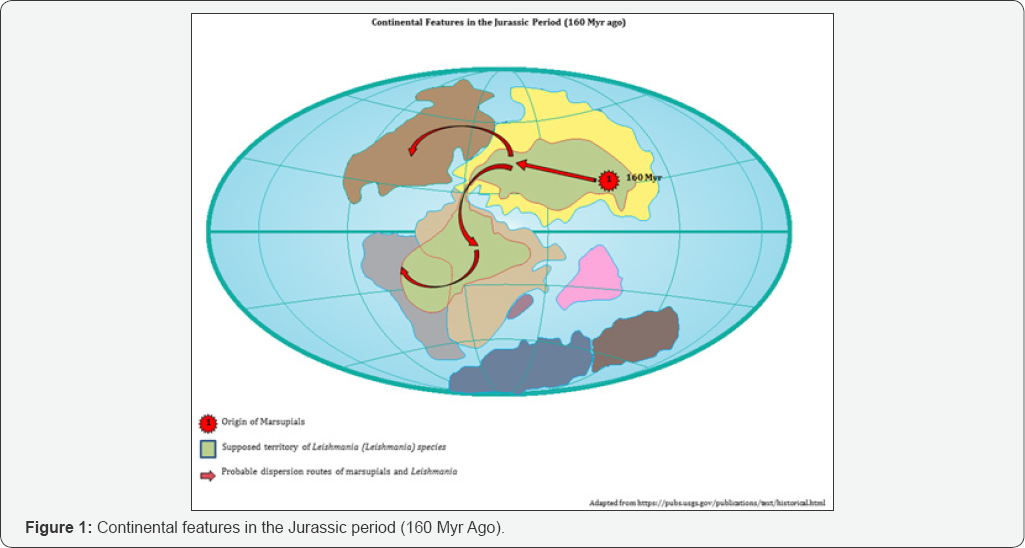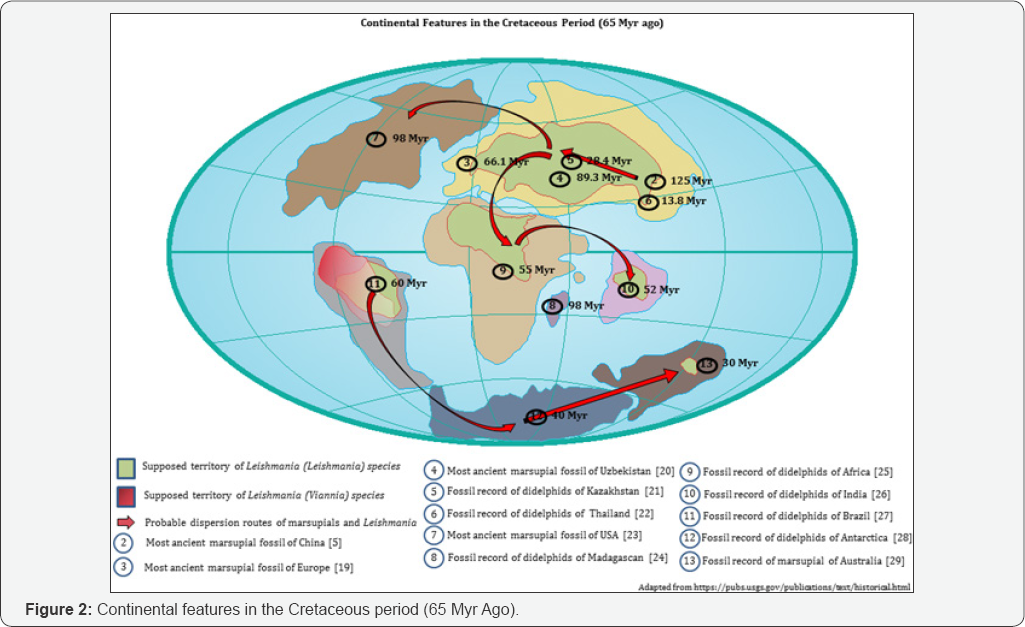Juniper Publishers- Open Access Journal of Case Studies
Were the Marsupials the Key Sylvatic Reservoir of Leishmania?
Authored by João Carlos Araujo Carreira
Editorial
Rodents have been classically considered as the most important mammal hosts of cutaneous Leishmania probably because they are in general very susceptible to the parasite infections and consequently present a great number of reports of animals naturally infected with skin lesions [1]. Another factor that could seemingly favor the importance of rodents is that currently there is no marsupials in the Old World.
Nonetheless, if we take into account the evolutionary history, biogeography and infection patters in relation to the probable role on the co-evolution with the parasite. In this case, the marsupials mostly prevail.
In respect to the evolution, most studies related to rodents recognize a post-Cretaceous origin (after 65Myr) [2]. Moreover, in South America the oldest rodent fossil record has been dated still later during middle Eocene (41Myr) [3].
On the other hand, the origin and evolution of marsupials occurred quite before, the most ancient fossil record proving the marsupial origin was discovered in Jurassic deposits, dated with about 160Myr in China [4]. Furthermore, the earliest known metatherian fossil, the opossum-like Sinodelphys szalayi, comes from the early Cretaceous Yixian Formation (125Myr) also from China [5].
Concerning the biogeographic records of marsupials, the majority of paleontologists accept that Metatheria originated in Asia, in the Jurassic. Then diversified throughout the northern continents and dispersed into Gondwana (the modern Southern Hemisphere) around the beginning of the Paleocene epoch (65 million years ago) [6]. Finally, they moved through Antarctica to Australia, before the Australian continent was isolated (37Myr) by the opening of Drake Passage between South America and Antarctica [7].
Thus, when the rodents were taking the first steps in their evolution, the opossum-like marsupials were already widely dispersed in the most part of the world where Leishmania currently occurs. Regarding the infections patterns, as above mentioned most rodents are very susceptible, commonly presenting tissue lesions and because of that they are typically used to the parasite isolation in laboratory. Otherwise, the marsupials are frequently asymptomatic, presenting scarce lesions [1].
Likewise, if we consider the infection of didelphid marsupials with some trypanosomes that are highly pathogenic to rodents [8], such as, Trypanosoma cruzi or Trypanosoma evansi. Under natural conditions the infections in didelphids are constantly sub-patent and symptomless [9,10] supporting the theory that marsupials and trypanosomatids probably have a very ancient co-evolutionary history.
Actually, the hypotheses about the arising of the mammals' Leishmania are controversial; while some authors have considered a Neotropical origin, others have suggested the probable emergence of the genus, either in the Palearctic or in the Nearctic region [11-13].
In the Neotropical origin, Noyes [11] proposed that a clade named Leishmania/Endotrypanum evolved in the Neotropics during the first half of the Cenozoic (65-40mya) and descendants of these parasites migrated through the Nearctic to the Palearctic no later than the mind-Miocene. Nevertheless, besides the opposite arguments reported by Kerr [12], posterior studies demonstrated that the stock of Endotrypanum (a sloth trypanosomatid) that was utilized to determine that clade, in fact was Leishmania. Therefore, the supposed clade Endotrypanum- Leishmania, it actually does not exist.
Probably the sloth from where the parasite was isolated had a mixt infection and at the laboratory, the Endotrypanum was lost, leaving only the Leishmania.
In the Palearctic origin, Kerr [12] based their theory on the fossil record and systematics of murid rodents. They also considered that the evolutionary pattern of New World rats (Sigmodontinae) indicates that they may be the most important reservoirs of zoonotic cutaneous leishmaniasis throughout their range.
Nevertheless, as already mentioned above, if we consider all the rodent groups, even those extinct, they present a very late evolutionary history, principally if we take into account their presence in South America [2,3].
In another theory about the evolution of Leishmania, Momem & Cupolillo [14] suggested that this genus appeared during the period Paleogene or Paleocene, following the extinction of the dinosaurs and the emergence of the first placental mammals. Consequently, the ancestors of Leishmania were separated into Sauroleishmania, infecting reptiles such as lizards, in addition of the Leishmania of mammals.
Perrotey et al. [15] suggested that the dissemination of the parasite went along with the migration of vectors and hosts together, and that the natural hosts of ancient Leishmania could have been either reptiles or primitive mammals [15].
More recently, Tuon et al. [16] supposedly based on geological evidences related to the separation of the continents in addition to the probable occurrence of hosts and vectors as well as molecular parameters; they proposed the origin of Leishmania could be occurred during one of the four ensuing geological periods: Triassic, Jurassic, Cretaceous and Neogene.
A common point of all the hypotheses proposed by Tuon et al. [16], consists of assuming that the origin of Leishmania occurred in Central Africa, consequently if it is currently thought that the first mammals emerged in Asia [4] during the Jurassic period (based in fossil records), consequently this aspect could represent an incongruence.
Anyway, based on the assertion that mammal Leishmania evolved from reptile parasites to primitive mammals and considering the above information related to the origin, biogeography and infection profiles in marsupials, we are proposing that those animals have had a key role on the evolution of Leishmania principally in the New World.
So, we presumed that the Leishmania of mammals originated in Asia at the Jurassic period infecting primitive marsupials, then they diversified throughout the northern continents following their Hosts and dispersed into Gondwana (the modern Southern Hemisphere) in the course of the Paleocene epoch (65 million years ago). It is probable that the first species of the subgenus Leishmania (Leishmania) have emerged during this time (Figure 1 & 2).
In the mean time in the Cretaceous, around 105Myr, when South America started splitting apart from Africa, probably the first species of the subgenus Leishmania (Viannia) could have emerged and diversified during more than sixty millions of years while South American was an island continent (Figure 2) [7].


Likewise, it is probable that some parasite species could even have followed their marsupial host moving through Antarctica to Australia before the Australian continent was isolated by the opening of Drake Passage between South America and Antarctica. Because it was already observed the existence of a close molecular relationship between a kangaroo Leishmania species and Leishmania enriettii, an enigmatic parasite species isolated from domestic guinea pigs in Brazil where potential vectors were also associated to opossum nests, but nobody knows its natural host until now [17].
Finally, some Leishmania species could have reached the Central and North American Continents quite after, when occurred the Great American Biotic Interchange that started in late Miocene (~10-7Ma) [18], rapidly increased after ~5Ma and during the Pleistocene [19-29].
For more articles in Open Access Journal of Case Studies please click on: https://juniperpublishers.com/jojcs/index.php



No comments:
Post a Comment